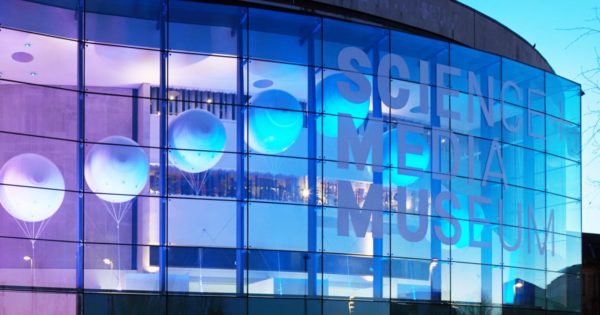Listening
In each small group discussion museum staff listened to a selection of ‘moments’. These can be found in Part 1. We sought to do this carefully, listening deeply in order to hear the issues raised from the standpoint of the authors. This led to often very moving discussions as staff reflected back what they heard people saying. Edited quotes of these responses have been complied and linked to each moment.
The moments in Part 1 were written by people who had been actively involved in the Bradford’s National Museum project in different ways. When developing their moment, each person carefully considered what they wanted the museum to hear. They looked back at their involvement in the project and drew out significant insights or realisations that happened along the way. They also looked forward and considered where they saw hope or possibilities for change. Once gathered, the moments were then used as part of the reflective process within the museum towards developing ideas for the Future Directions of the museums’ relationships with Bradford set out in Part 3.

The reflective moments were listened to by museum staff before links to their everyday practice and the future directions of the museum were identified. Image credit: National Science and Media Museum / Science Museum Group
When staff came together to discuss these pieces of writing they started by listening. We explored questions like ‘what do I hear this person say?’ ‘What are their motivations for saying this?’ ‘What, for this person, might be behind what they are sharing?’ This process of careful and deep listening to people who see the museum from different perspectives was an important first step. In the second part of the session museum staff then considered how the thoughts prompted by the moments might relate to their professional roles.
Sharing stories in this way is a common practice in action research and organisational development. It enables people to more easily take on others’ perspectives. Those reading and listening started seeing the project through different eyes, whether those of colleagues in different teams or those of Bradford collaborators who joined at different points over the three years of the project. One of the other shifts that deep listening offered was to create a space where there was no pressure to immediately fix problems or jump to solutions. Instead, the focus was on first recognising the complexity of the issues.
There were many viewpoints that were surprising to staff members. There were times when readers were touched by the honesty and rawness of experiences, suddenly aware of issues they had not even known existed. For some the approach allowed for people to say what they could otherwise not say, precisely through the new opening created by someone else’s experience. We took verbatim notes of the discussion and then worked with staff to create edited quotes for inclusion in this publication. The staff responses to the moments can be read either as a link at the end of each moments or below.
Listening first gave a different, richer and expanded starting point for staff to consider their own practice. It was after listening, when staff went on to discuss the moments related to their own everyday working life that the tensions between different perspectives, viewpoints and positionalities came into new focus.
-
Listening to Aamir
The comment Aamir made about ‘deflection’ stuck out for me as something that is really, really common. My experience is that...
-
Listening to Alice
I like the idea of Alice saying that the museum is a civic museum. That resonates with me. What we...
-
Listening to Anandi
I can hear Anandi’s frustration, which is so understandable when your history has been marginalized and misunderstood for so long....
-
Listening to Andy Abbott
What I found interesting is that in the criticisms he is offering, I think he is asking about the middle...
-
Listening to Andy Clarke
I hear the isolation Andy felt. That is the bit that is overlooked if you are not part of a...
-
Listening to Barbara
The process of putting together an exhibition is about much more than the end result. Barbara discovered more about her family archive than she expected to...
-
Listening to Chris
It is interesting how Chris’ story mirrors Sajidah’s point. He talks about relationships that are more than a means to...
-
Listening to Claire
I recognise the lack of time Claire talks about. I started off coming to the staff group meetings, but with everything that has happened this year,...
-
Listening to Elizabeth
Elizabeth sounds very positive about the new connections she made through the project. Sometimes I think Bradford Museums & Galleries might work in similar internal bubbles to us. Our departments and teams can work quite individually,...
-
Listening to Geoff
I think what Geoff articulating is his theory of change. I think he is thinking about how structural change comes...
-
Listening to Gin
I hear Gin talking about the monolith that the Science Museum Group feels like to her. I wanted to know...
-
Listening to Hal
There are many ways for museum to collaborate, with differing approaches to decision making. Handing over all decision-making power to...
-
Listening to Helen
Why is a pop-up different from an exhibition? The question is what the size and focus of the exhibition is....
-
Listening to Jean
These are all things the museum could have done. The idea to take a lead in to discuss the methodology,...
-
Listening to Jo
Reading Jo’s piece, I hear the feeling so many of us in the museum experience, of how difficult it is...
-
Listening to Joan
It was interesting to read what Joan says about the Irish community in Bradford. I learned a lot from that...
-
Listening to John
When I read about the trip John talks about, I thought of how I didn’t know about any of this...
-
Listening to Mary
How she was describing coming up to the office…it seems like we are so inaccessible. There are so many barriers...
-
Listening to Maureen
I hear pride, Maureen is proud. She doesn’t sound like she is being patronised in any way, she feels the...
-
Listening to Nabeelah
Nabeelah’s words remind of the importance of continuing our process of learning. Having the conversations we are having now is not a one-time thing, we need to...
-
Listening to Pakeezah
I am very emotionally impacted by the things Pakeezah says. I am shocked by the comments she had to deal...
-
Listening to Rameez
Rameez sounds happy with how the work we did manifested, which I am happy to hear, that is how good...
-
Listening to Sajidah
I like the idea of a blank canvas for everybody to shape. Laura Slevin, STEM Ambassador Engagement Officer I am...
-
Listening to Sarah
I feel Sarah’s frustration about how we often end up focusing more on internal processes or logics, rather than people. She says that...
-
Listening to Si
The family is everybody who lives and works in Bradford. It changes and is dynamic, but it holds together. It...
-
Listening to Sonia
I am overwhelmed by Sonia’s willingness to collaborate in fixing these problems. I don’t know that we deserve this, but...
-
Listening to Tim
Tim and I got to know each other really well over the last two years. It’s really encouraging to hear Tim’s good...
-
Listening to Vicky
I hear Vicky talking as somebody who is very local in Bradford. If she invites people to come to the...
-
Listening to Wahida
I hear Wahida say that there could have been more, the museum could have done more. There is frustration in...
-
Listening to Will
I hear Will say that unsettling and trying something different is what evokes change. Laura Slevin, STEM Ambassador Engagement Officer...
Listening to other’s perspective, inviting many viewpoints, is something we built into the project throughout. Our approach, talking not to understand or to find a simple solution, but to open issues up, sometimes felt for those involved like we were just talking. I remember a comment made in a staff group meeting: ‘we don’t just want a talking shop again, we need to get to the doing’, which makes total sense. Nobody needs empty words.
As a facilitator my job is to make sure we are not just talking. The aim is to use conversation to create shared understandings, to do vital critical thinking and to shape our practice, the ‘action’ in action research. The talking becomes part of making change. Through conversations and sharing, questioning, experimenting and learning together museum staff were changing how they think about their work and their positionalities in their roles, the museum and Bradford. Doing learning like this with colleagues and partners has practical impact. Some relationships were forged, some changed, some people felt empowered to say what they didn’t dare say before. Organisational processes were adapted to support different ways of collaborative working.
Making change in this way is not what most of us are used to. It’s a different way of working to what we do throughout education or jobs. Much of our day to day doing pretends the world is simple, we aim to organise mess and challenges away. From my own experience I can say learning to work with, not against, complexity is difficult and uncomfortable. As humans, to a degree, we are built to categorise and simplify, to solve problems.
A process of ongoing change – that underpins the Tensions as Strengths approach – needs different worldviews and skills. Developing these new ways of working in the museum was a challenging journey and one that is still ongoing.
Julia Ankenbrand, Research Facilitator



